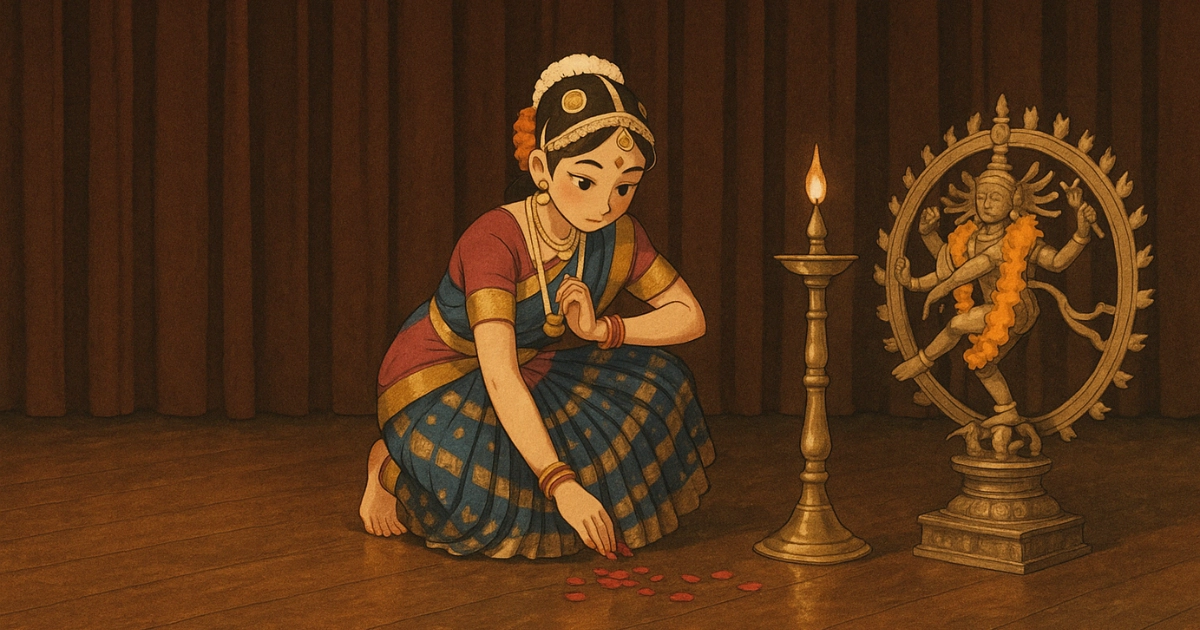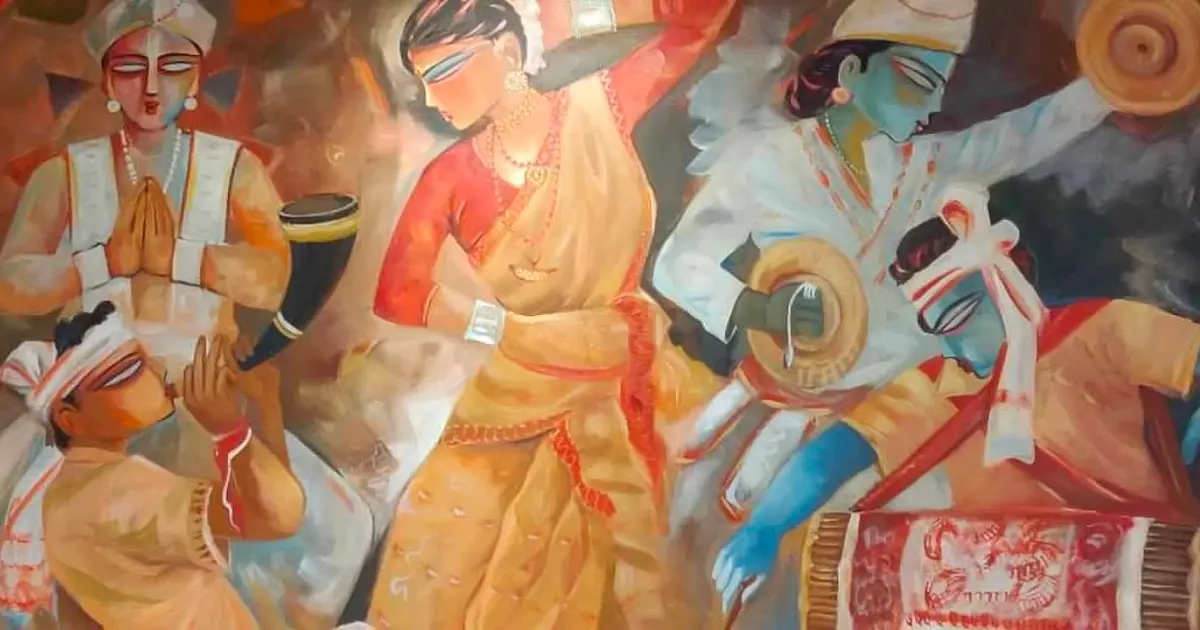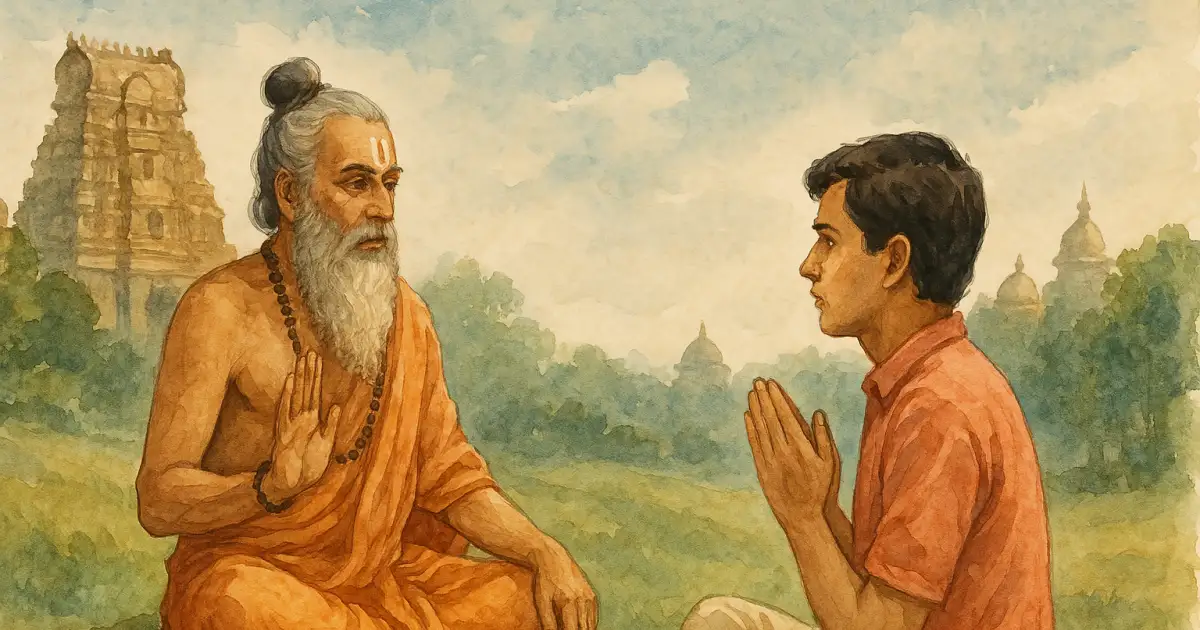Our traditions are always alive among us,
even when we are not dancing;
but we work only that we may dance.
Huitoto Saying
Secular man has slowly but surely been stripping the world of its sacred dimensions, with modernity irrevocably altering our relationship with the sacred. Classical dance traditions have been no exception. The welcoming of J.D. Vance, VP of the United States of America with Bharatanāṭyaṁ being performed on an airport tarmac has exemplified this secular misuse and vulgarization of dance by state apparatuses for political optics. The debasement of dance traditions is a sorry spectacle, and the erosion is not merely aesthetic; it is spiritual. It reflects a collective amnesia about the purpose of nāṭya, and signals a tragic disconnect from the dhārmika vision that once gave life and meaning to these exquisite art forms.
The Sacred Essence of Nāṭya
In the Hindu tradition, nāṭya — classical dance — is not merely an art form. It is a sacred discipline or sādhanā, a mode of bhakti, and a vehicle for spiritual elevation. Its origins are deeply entwined with the Purāṇas and Itihāsa: it is said that Brahma himself created Nāṭya Veda, combining elements from the four Vedas to show us a path to both teach and transcend through performance. As Kapila Vatsyayan writes, “Indian dance, like Indian poetry, music and sculpture, seeks to communicate universal, impersonal emotion, and, through the very medium of the human form, it transcends the physical plane.”
Nāṭya is not only rooted in the Purāṇas and Itihāsa but it is considered a re-actualization of the foundational texts, as an earthly reenactment that serves as a civilisational continuum of remembering, thereby restoring cosmic order (ṛta).
Laden with rich religious and philosophical meaning, Hindu classical dance forms have never been meant for profane entertainment; they are intended to enrich and elevate both performer and audience through the senses, towards that which is beyond the senses -
The Hindu mind views the creative process as a means of suggesting or recreating a vision, however fleeting, of a divine truth; and regards art as a means of experiencing a state of bliss akin to the absolute state of ānanda or jīvanmukti (release in life). The spectator must also thus have an inner preparedness to receive this vision and be a potential artist; he is a rasika, a sahṛdaya, one who is capable of responding.
Kapila Vatsyayan, Classical Indian Dance in Literature and the Arts (1968)
Sacred Space or Kṣetra
According to the Nāṭyaśāstra, before any classical performance could begin, it was essential to sanctify both the performers and the performance space (playhouse/stage) through elaborate rituals known as pūrvaraṅga. These rites are not mere formalities — they are spiritual preparations, intended to transform the stage from a mundane setting into a sacred space (kṣetra). These rituals involved the entire troupe — dancers, musicians, and assistants—participating in a series of offerings and invocations to the Gods:
This [consecration] should take place after he has made obeisance to the great god Śiva the lord of all the regions, Brahman who sprung from the lotus, Bṛhaspati the preceptor of the gods, Viṣṇu, Kārtikeya, Sarasvatī, Lakṣmī, Siddhi, Medhā, Smṛti, Mati, Candra, Sūrya, Winds, Dikpālas, Aśvins, Mitra, Agni, and other gods, such as Rudra, Varṇas (deities ruling over the caturvarṇas), Kāla, Kālī, Yama, Niyati, the Sceptre of Yama, the weapons of Viṣṇu, the Lord of the Nāgas, the Lord of the birds (Garuḍa), Thunderbolt, Lightning, Seas, Gāndharvas, Apsaras, Sages, Nāṭyakumāris, Mahāgrāmaṇi (the great leader of Gaṇas), Yakṣas, Guhyakas and the hosts of Bhūtas.
Nāṭyaśāstra III 1-8
The Nāṭyaśāstra prescribes that specific deities are to be enshrined in designated positions on the stage, behind the curtain, and even in the aisles and passageways. Offerings such as lamps, flowers, sandalwood paste, incense, garlands, fruits, rice cooked with ghee, and sweets are to be made, accompanied by the chanting of mantras. These acts are not just symbolic — they are integral to consecrating the performance as an offering to the gods, aligning the art with the divine.
Offering worship to the gods of the stage is as meritorious as a [Vaidika] sacrifice. No dramatic performance should be made without first worshipping the deities presiding over the stage. When worshipped, they (these gods) will bring you worship, and honoured they will bring you honour. Hence one should by all efforts offer Pūja to the gods of the stage.
Nāṭyaśāstra III 96-97
This elaborate, sacred preparation is believed to bring a sense of mental clarity and spiritual calm to the performers, enabling them to transcend their ego and perform with full devotion. To bypass these rites and use the art form casually, as a tool for statecraft or political display, is to sever it from its sanctified origins. The ritual sanctification of space is not incidental — it is foundational to the very spirit of nāṭya. Without it, the performance ceases to be a sacred act and becomes mere spectacle.
The consecration of the stage is also symbolic of the recreation of a cosmic sacred space in the worldly realm. Connecting this principle to the writings of renowned anthropologist Mircea Eliade, in his seminal work ‘The Sacred and the Profane’, such a creation of a sacred space is a foundational act through which the world is revealed, ordered, and made habitable for religious man. It begins with a hierophany — a manifestation of the sacred, or the divine, in the ordinary world — essentially, an irruption of the sacred into the profane — that marks a particular location as qualitatively different from all others. This place becomes the axis mundi, the center of the world: linking heaven, earth, and the underworld, and thereby offering orientation and a fixed point in the chaos of undifferentiated space. There is an inherent cosmogonic value to the ritual orientation and construction of the sacred space. Eliade writes, “Every sacred space implies a hierophany... making it qualitatively different,” and this differentiation is not merely symbolic but existential. The act of establishing a sacred space is equivalent to a re-enactment of the divine creation of the cosmos; it is through this symbolic repetition that man situates himself in the universe, abolishes chaos, and begins the process of living in accordance with a transcendent order. Thus, sacred space is not merely a setting for worship — it is the very condition for meaning, identity, and participation in the divine structure of reality. Eliade observes that the religious man desires to live as close as possible to the divine models. This is why his life is a succession of imitations of paradigmatic gestures. This mirrors the fundamental principle of nāṭya as set out in the Nāṭya Śāstra, where performances reflect divine templates and evoke universal emotions (rasas).
Eliade further articulates the profound transformation brought about by modernity as a gradual desacralization of the world — a historical and cultural rupture that distances modern man from homo religiosus (religious man). Whereas religious man once inhabited a cosmos imbued with divine presence, structured by symbolic meaning and oriented toward the sacred, modern man now moves through a world perceiving it as inert, disenchanted, and spiritually opaque. In this desacralized condition, space is no longer distinguished by hierophanies, time no longer cycles back to mythical origins, and matter no longer serves as a vessel for the sacred.
The result is a homogenized, utilitarian reality in which symbolic depth has been supplanted by functional surface—an existential flattening that leaves modern man estranged not only from the divine but from the very structures that once conferred meaning upon existence.
Nāṭya as Political or Secular Spectacle
Traditionally, nāṭya was performed in temples (kṣetra) as an act of worship, as part of rituals offered to the deity, or during festivals as sacred offerings. The temple was never regarded as a mere stage and the dancer was never seen as a mere entertainer — they are devotees first and foremost. It is improper to use classical dance as a medium for commentary on frivolous matters (such as social issues) bound by contemporary time and space, or themes based on the performer’s individual opinions or ego. Yet, today, there has been a tragic inversion. Hindu classical dance is increasingly repackaged as “cultural performance” for secular events — reduced to a decorative showpiece for foreign dignitaries, including those whose ideological affiliations are not only indifferent but often hostile to the Dhārmika worldview. In particular, the trend of using Bharatanāṭyam or Odissi to welcome foreign politicians — figures who have little respect for or understanding of Indic traditions — that too in in odd locations — breaching prescribed ritual — reveals a disturbing erosion of sacred boundaries.
The Crisis of Patronage and State Appropriation
This vulgarization is not accidental. It is the product of two intersecting crises: the collapse of traditional patronage (temples, kings, dhārmika households), and the monopolization of Hindu art sponsorship by a largely secular, bureaucratic Indian state. Government agencies, rudely indifferent to the spiritual purpose or content of nāṭya, are content to preserve only its external form. Dancers, in search of income and recognition, are forced to perform for an audience trained to consume culture without reverence and reduce the exalted, sacred art form to merely one of the many modern forms of entertainment. This inevitably pushes the sacred art toward superficiality, detaching it from its spiritual and religious roots.
The Loss of Sacred Context
Such state-sponsored performances distort both the purpose of the art and the dignity of the artist. By ripping sacred forms from sacred spaces and transplanting them into secular arenas — five-star hotels, political galas, international summits — the government reduces nāṭya to a sanitized, folkloric token, a gesture of “soft power” stripped of inner power. This is not preservation but a profanation. Nāṭya is not a cultural commodity and Hindu traditional dance forms are not an ornament of the nation-state — it is a limb of Dharma. It belongs in the kṣetra, in the context of yajña, pūjā, or sādhanā — not on an airport tarmac. To treat nāṭya as cultural window-dressing is not only a misunderstanding but desecration.
In conclusion, nāṭya has a time and a place. It must not be repurposed as a tool for appeasement or as a form of empty spectacle. It must remain rooted in its original intent: spiritual awakening, ritual, and devotional offering. Only then can it continue to live, not as a fossilized art, but as a living, breathing current of Sanātana Dharma.
References
- Eliade, M. (1961). The Sacred and the Profane: The Nature of Religion. Harper & Row.
- Vatsyayan, Kapila (1968), Classical Indian Dance in Literature and the Arts.
- The Tradition Of Natya: Position And Development Of Natya In Sanskrit Tradition (Part 2: Ancient Indian Theatre) by Dr Sharda Narayanan.







